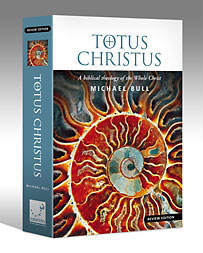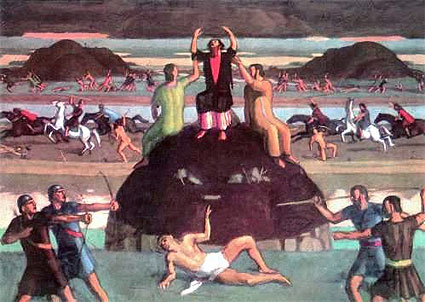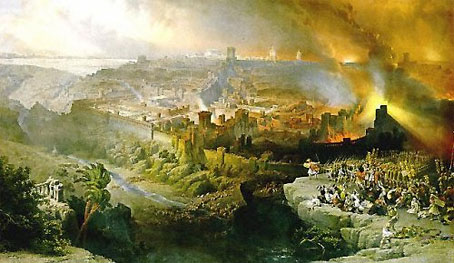Apr
10
2009
I recently found a quote that deals wonderfully with the argument that Genesis was just a story written to refute the errors in the paganism of the time, not to describe the actual biological history of the world:
“…while it’s quite unlikely that Moses was thinking, “Take that, Darwin!” when he set pen to papyrus, it will turn out that by refuting Enuma Elish, Genesis also refutes Darwin, because Darwinism, at bottom, is nothing but Enuma Elish baptized in post-Enlightenment balloon juice. Anyone with Longman’s literary expertise ought to see this very clearly.
Enuma Elish says the world as we know it today was born in an orgy of chaos, sex, and death, and these three forces are the engine from which all life springs. Darwin explains that the various species arise from a combination of random mutation (chaos) and natural selection (sex and death). The big difference is that Darwin said it in a way that post-Enlightenment man wouldn’t laugh at. Hawking likewise has nothing to add that Enuma Elish hasn’t already offered to the world, only to have Genesis soundly refute it.”
You can read Tim Nichols’ full article here:
How Not To Read Genesis
2 comments | tags: Enuma Elish, Genesis, Hermeneutics, Moses, Tim Nichols | posted in Apologetics, Creation, Quotes
Apr
10
2009
Is Genesis 1 history or myth?
“The expositor [of the creation narratives] must move knowingly between two temptations. On the one hand, there is the temptation to treat this material as historical, as a report of what happened…. On the other hand, there is the temptation to treat these materials as myth, as statements which announce what has always been and will always be true of the world…. Our exposition will insist that these texts be taken neither as history nor as myth. Rather, we insist that the text is a proclamation of God’s decisive dealing with his creation.
The word “creation” is controlling for such a view. The whole cluster of words—creator/ creation/ create/ creature—are confessional words freighted with peculiar meaning. Terms such as “cosmos” and “nature” should never be carelessly used as equivalents, for these words do not touch the theocentric, covenantal relational affirmation being made…. The text, then, is a proclamation of covenanting as the shape of reality…. This theological affirmation permits every scientific view that is genuinely scientific and not a theological claim in disguise.”
—Walter Brueggemann, Genesis (Interpretation Commentary), pp. 16-17.
I agree that the Creation narrative sets the foundation for the structure of later Covenants, and also of the construction of the Tabernacle and Temple, but the explanation above is just a fancy dance to avoid the unavoidable bullet that is Genesis 1. So it’s a proclamation that affirms theological truth but not historical truth? No wonder the western church is in a pickle!
When faced with an issue in which you wish to fence-sit, REDEFINE the terminology:
“In the last analysis, the Old Testament doctrine of creation expresses a sense of the present situation of man. He is hedged in by the incomprehensible power of Almighty God. The real purpose of the creation story is to inculcate what God is doing all the time…. Thus the doctrine of creation expresses man’s sense of utter dependence on God.”
—Rudolf Bultmann, Primitive Christianity in Its Contemporary Setting, p. 18.
If Genesis 1 is not history, and it is not myth, it is ideology. Which makes this plain old boring gnosticism. These smart guys just don’t get it, do they?
As one of my old Bible teachers used to say, “If someone’s taking an odd position, there’s a bee in his pocket.”
Comments Off | tags: Brueggemann, Genesis, Gnosticism, Hermeneutics | posted in Apologetics, Creation, Quotes
Apr
10
2009
“Behold, the day of the LORD comes, Cruel, with both wrath and fierce anger, To lay the land desolate; And He will destroy its sinners from it. For the stars of heaven and their constellations Will not give their light; the sun will be darkened in its going forth, and the moon will not cause its light to shine.”
You’ll never understand a book if you only ever read the last chapter. If you thought this quote was from the New Testament you are almost right. It is from Isaiah 13, and Jesus quotes it. It begins: “The burden against Babylon which Isaiah the son of Amoz saw…”
Would Jesus’ audience have thought He was referring to the destruction of the cosmos? Nup. They would (or should) have realised that He was calling Judah a new Babylon, and that the “sun, moon and stars”, the governing lights of her kingdom were about to come crashing down.
Jesus had a sharp mind, and a sharp mouth. A lot sharper than us when we misinterpret Matthew 24.
Comments Off | tags: Apocalyptic, Babylon, Hermeneutics, Isaiah | posted in The Last Days
Apr
10
2009
 “And now, indeed, the hand of the Lord is upon you, and you shall be blind, not seeing the sun for a time.” And immediately a dark mist fell on him, and he went around seeking someone to lead him by the hand.” Acts 13:11
“And now, indeed, the hand of the Lord is upon you, and you shall be blind, not seeing the sun for a time.” And immediately a dark mist fell on him, and he went around seeking someone to lead him by the hand.” Acts 13:11
The blindness of Elymas caused Sergius Paulus to believe. The temporary blindness of a Jew brought about the conversion of a Gentile.
A repeated symbolic concept in Scripture is that of sight and blindness. Samson and King Zedekiah both lost their eyes. Isaac and Eli were blind. From Genesis 1:4, 3:6 and 6:2 we learn that eyes are organs of discernment and judgment. The process of maturity makes wise judges who are “the eyes of the Lord”, walking “to and fro on the earth”, collecting evidence to present before His court. Bible symbols are consistent, and their meanings become plain to the saints with their “new eyes.” Those who refused to obey the gospel twisted the Scriptures to their own destruction (2 Peter 3:16).
“For I do not desire, brethren, that you should be ignorant of this mystery, lest you should be wise in your own opinion, that blindness [hardness] in part has happened to Israel until the fullness of the Gentiles has come in.” Romans 11:25
…Herod and the Jews had symbolically become Egypt, hardened like Pharaoh (Romans 9:17-18; Hebrews 3:16; 8:9; 11:26-29; Jude 1:5; Revelation 11:8). The old Jerusalem was Hagar, and the New Jerusalem was Sarah. Christians, not Jews, were “the promised child.” Judaism had become childless like Naomi, and it was only the “fullness” of outsiders, Peter’s “unclean animals”—Ruth—that rescued the people of God from spiritual famine, the extinction of unbelief. The barrenness of Egypt was replaced with the harvest of Pentecost.
…Agabus the prophet foretold a famine in Judea (the curse for the shedding of Stephen’s innocent blood), but the Antioch saints sent relief (the richness of ‘Ruth’) to those in Judea.
Comments Off | tags: Acts, Isaac, Paul, Ruth, Samson, Typology, Zedekiah | posted in Biblical Theology, The Last Days, Totus Christus
Apr
10
2009
Regarding churches claiming apostolic authority, particularly the Catholic/Protestant divide, something that is overlooked is that worship was centralised on earth but this ended in AD70. It was possible for Satan to roll the political power of Rome into bed with the religious authority of Judaism, and bring both systems down upon all true worship as persecution.
Since that time, the centre of true worship is in heaven. It is now impossible for Satan to corrupt or attack its centre because the new Jerusalem is above. We see this in Revelation 2-3. Not only is the menora now split into seven separate lampstands, the lampstands are in the holy place, seated with Christ.
So, when the Roman church became corrupt, God’s people came out. When protestantism becomes corrupt, God’s people come out. As Christianity declines in the west, it is booming in the southern hemisphere. Satan is bound from mounting an all-out worldwide attack on the church until he is released for a short time, and then only so he can be drawn out of Egypt like Pharaoh to be destroyed.
There is an institutional church, but in her visible form she is only ever local assemblies. The ‘city of God’ is in heaven, incorruptible, unassailable. If her earthly ‘branches’ leave the vine, they wither up. When they have only darkness to share, Jesus snuffs them out. They are no longer ‘the church’ regardless of whether the physical institutions remain.
Magisterially, the church governs from heaven. The new Jerusalem will descend at the end of history, but any attempt at a centralised, earthly city of God before then is doomed to failure, Roman Catholic or otherwise.
Comments Off | tags: AD70, Church History, Ecclesiology, Eschatology, Roman Catholicism | posted in Ethics
Apr
10
2009
Postmillennialism and preterism
from davidpfield.blogspot.com
“It’s been a very long time since I looked at Louis Berkhof’s Systematic Theology. But when I was flicking through it today I noticed a section called “Objections to Postmillennialism”. This is in his first paragraph:
There are some very serious objections to the Postmillennial theory.
The fundamental idea of the doctrine – that the whole world will gradually be won for Christ, that the life of all nations will in course of time be transformed by the gospel, that righteousness and peace will reign supreme, and that the blessings of the Spirit will be poured out in richer abundance than before, so that the Church will experience a season of unexampled prosperity just before the coming of the Lord - is not in harmony with the picture of the end of the ages found in Scripture. The Bible teaches indeed that the gospel will spread throughout the world and will exercise a beneficent influence, but does not lead us to expect the conversion of the world, either in this or in a coming age. It stresses the fact that the time immediately preceding the end will be a time of great apostasy, of tribulation and persecution, a time when the faith of many will wax cold, and when they who are loyal to Christ will be subjected to bitter sufferings, and will in some cases even sealed their confession with their blood, Matt. 24:6-14, 21, 22; Luke 18.8; 21.25-28; II Thess. 2:3-12; II Tim. 3:1-6; Rev. 13.
I don’t know about “just” before the coming of the Lord but what I found most striking was that, in my view, every one of the six passages he cites in defence of his objection to postmillennialism has reference to first century events.
There are other things to say about the relationship between postmillennialism and preterism but I thought this remarkable.”
Comments Off | tags: David Field, Postmillennialism, Preterism | posted in Against Hyperpreterism, Biblical Theology, The Last Days
Apr
10
2009
Attack from the Abyss

As with most things in the Bible the pattern begins in Genesis.
Unlike the serpent’s warriors, who live by the sword, God’s warrior is a father-ruler who fights only to protect those in his care. Nimrod was a serpent-king—a dragon; Abram was a servant-king, God’s answer to Nimrod the ‘rebel’ (most likely Gilgamesh).
Satan’s attack on ‘the offspring of the woman’ through Pharaoh had failed, so he resorted to inciting a conspiracy of nations. The serpent became a dragon. But Abram (as a good Gilgamesh/Nimrod), along with the men of his household, defeated them, rescued Lot and his family, and very importantly, plundered the attackers. The darkest nights that God allows are always opportunities for more glory. And, this being HOLY war, Abram refused the ‘devoted’ plunder.
The next instance involves Amalek, who attacked Israel in the wilderness, and mercilessly picked off the stragglers. Once again, God’s man “came down” to fight – in Joshua, at Moses’ command – with Moses, Hur and Aaron as Ark and cherubim on the holy hill, the “garden gate”.
“The Lord will have war with Amalek from generation to generation.” (Exodus 17:16)
This statement about Amalek is more loaded than it seems. Amalek was defeated, and the plunders from the victory were devoted to building God’s house in the wilderness. We will see this pattern again and again. Each time, deliverance for God’s people is on a greater scale, and the defeat more catastrophic for His enemies.
Comments Off | tags: Aaron, Abraham, Amalek, Genesis, Holy war, Moses, Nimrod, Pharaoh, Tabernacle | posted in Against Hyperpreterism, Biblical Theology, The Last Days, Totus Christus
Apr
10
2009
A Conspiracy of Nations
Amalek is the archenemy of the saints. This first Amalek most likely descended from Japheth. Numbers 24:20 paints him as the original great “Sea beast”, and a counterfeit Alpha and Omega.
“Amalek was the first of the nations, but his end shall be destruction.”
Esau moved to Mount Seir and merged with the Horites to become ahybrid part-Canaanite people known as Edomites. One of Esau’s grandsons was named Amalek (Genesis 36:16), which shows a conscious or subconscious alliance between Gentile hatred and false brother hatred of God’s chosen son—a “Land beast”. This has an enormous impact on interpreting the later history of the Bible.1
Continue reading
Comments Off | tags: Amalek, Bible history, Deborah, Edomites, Esau, Jabin, Jericho, Judges, Resurrection, Sisera, Solomon, Typology | posted in Against Hyperpreterism, Biblical Theology, The Last Days
Apr
10
2009
Saul and Agag
 I puzzled over Ezekiel chapters 38 and 39 for years. Bible commentators suggested many things but nothing seemed to fit the historical context of the surrounding chapters. It seems James B. Jordan was the first to put the pieces together.1
I puzzled over Ezekiel chapters 38 and 39 for years. Bible commentators suggested many things but nothing seemed to fit the historical context of the surrounding chapters. It seems James B. Jordan was the first to put the pieces together.1
Continue reading
Comments Off | tags: Amalek, Atonement, Babylon, Bible history, Esther, Ezekiel, Gary DeMar, Haman, James Jordan, Mordecai, Saul, Typology | posted in Against Hyperpreterism, Biblical Theology, The Last Days, Totus Christus
Apr
10
2009
Counterfeit Kingdom Come
Then the dragon became furious with the woman and went off to make war on the rest of her offspring, on those who keep the commandments of God and hold to the testimony of Jesus. And he stood on the sand of the Sea. Revelation 12:17 [ESV]

“After a number of years of peace for the Church (Acts 9:31), Wormwood poured out his poisonous waters, false Judaising doctrines, to try and corrupt the woman. God raised up Paul to defeat Satan and the Judaisers, and meanwhile the land (the Circumcision) drank up his false doctrine. Satan has engaged in two tactics: persecution and corruption. These have failed. So now he decides to return to persecution, but this time against the non-Jewish believers, the “rest of her offspring”. He stands on the sands of the sea, addressing the Roman Gentile sea, and raises up the Sea Beast.”1
Continue reading
Comments Off | tags: Amalek, Compromise, Daniel, Haman, James Jordan, Nebuchadnezzar, Paul, Revelation, Satan, Totus Christus | posted in Against Hyperpreterism, Biblical Theology, The Last Days, Totus Christus





























